Body-Flow™ Yoga for the Ground Game
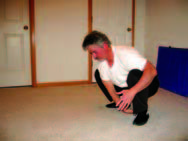
As a student of the ground game almost everyone has been asked to perform movements like the Upa, shrimping, hip heists, penetration steps, as well as various rolls and falls, pushups, sit-ups, arm bar rolls, et cetera, as a part of their class warm up (though they might be called different names depending on your style of grappling). These simple elementary exercises make up the majority of the movement prep for most of the grappling schools. They are simple to learn, and in a skill development sense easy to do. But they are called “elementary” for a reason. There is nothing sophisticated about them, and when done in volume they can lead to a negative training effect creating residual muscle tension that interferes with skill acquisition.
There is a similar tendency in most BJJ/submission grappling classes when learning submission techniques. The instructor introduces the techniques – somewhere between one and five per lesson – with a lot of time allotted to working on the minutiae of the technique. But very little time spent on developing a method of getting to one from another. The student is often left to his own devices on that developmental front.
I have been in many classes that worked like that. A good example of this was once when I first started studying submission grappling I was in a class where we learned three techniques back to back, with the idea of “chaining” them together into a series of attacks: the Kimura from guard, the guillotine and a crucifix-type thing. We worked on the techniques individually, paying strict attention to all the details of setting them up and getting into them. Then the instructor said, “Okay, you got it, let’s roll.” Nowhere was there any instruction on how to get from one to another. So, like the good student I am, I asked: “What do I do with my hips? How do I transition to a hip-bump from the guillotine to get to the crucifix? And how am I supposed to figure all this out while some testosterone-laden gi-wearing monkey is trying to wrench my arm out of its socket?” All the instructor said was: “Welcome to the food chain.”
Yeah, thanks, and your check is in the mail…
To help sophisticate, and in a lot of cases, compensate for their practice some long-term grapplers have turned to Ginástica Natural or yoga as adjunct methodologies to help their grappling.
That is what I did. I started practicing Hatha yoga in 1982 after I started my Judo practice with a college Judo club at Colorado State University. I started practicing yoga for a variety of reasons, one of the major ones being that Judo, more than any combat sport I’ve ever undertaken – except perhaps MMA – took its toll on my body.
I started Judo just before I turned twenty, after ten years of amateur boxing, seven years of Okinawan Karate and two years of amateur kickboxing (at that time PKA rules). Judo kicked my patootie in ways I didn’t know it could be kicked. Way more than any of the other combat athletics I was involved in. By the end of my five-year college term I had amassed a pretty extensive list of injuries. None of them bad enough to keep me away from it for long, but cumulatively they added up.
Though it took some time to learn, yoga helped mitigate a lot of those injuries, helping to keep me on the mat. Yoga also helped me to develop more isometric strength – to resist submissions – that all the “conventional” weight lifting didn’t seem too. Which was a good thing, for though Judo’s ground game is generally faster and looser than most BJJ – due to their respective rule systems – it still worked similar positions and submissions, and that type of strength development was a necessary component.
Many, beside myself, have noticed that there is a lot of positional cross over between yoga and BJJ. And there is. Frog position is similar to the mount, child pose is similar to the turtle, you transition in and out of the boat pose while in open guard, et cetera. Watch some really good BJJ/submission guys rolling and you’ll see all kinds of “yoga-like” movement at play. Scorpions, downward dog, split squats, crane posture, shoulder bridges; the list goes on and on... The problem with yoga as a developmental tool for BJJ isn’t in its asanas. It’s in its training pace and methodology.
The major drawback of most “styles” of yoga for a submission athlete is that it is largely a static practice. The transitions between asanas tend to be linear – a straight line designed to get you from one pose to the next pose that you're going to be working on, which you then hold for anywhere between several seconds to several minutes depending on the "style," instructor and setting. Think Sun Salutation B from Ashtanga Vinyasa Yoga. If you have the room for a “yoga mat” you can do most forms of conventional yoga. But who – as a grappler – gets into a position on the ground against a resisting opponent and holds that position (unless it’s against his will) for a great length of time? And where have you ever seen a transition between submissions, or from sweeps to submissions, that are linear while wrestling? The nature of grappling with an opponent makes everything curvilinear or circular because you have to get around his mass.
Enter Body-Flow™
Body-Flow™, which was released by RMAX Head Coach Scott Sonnon in 2003, was an evolution upon an earlier RMAX release called Grappler’s Toolbox™. Body-Flow™ (as was the earlier GT) was an eye opener for me. Here was both a training methodology AND a set of positional “exercises” that I could make immediate use of in the development of my ground game. Prasara Body-Flow Yoga™ – released in 2005 – is the latest evolution of that methodology – one with a direct link to yoga asanas.
Before I go too far, you might ask, why did I think I “needed” this? My answer is, like the example I wrote above, that I was tired of an instructor-type telling me, “Here is position a, b, and c. Now put them together and see if you can use them,” without giving a clue as to how to get from position a-to-b-to-c, let alone develop a game out of it. Instead everything was a “mad scramble,” which in Judo, or with the wrestlers I trained with, often meant that those with the best attributes won. And, frankly, that sucked. Even before I found GT and Body-Flow™, I “knew” there had to be a better way to train the transitions between positions than grunting, scrambling and hoping for the best. I just didn’t know what that was.
An example of a simple Prasara Body-Flow Yoga™ Progression
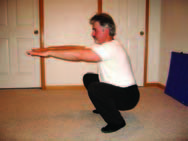
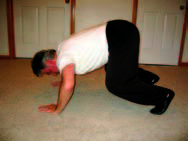
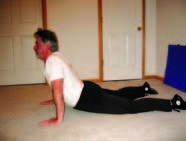
Flatfoot squat to frog position, worm to upwards dog...
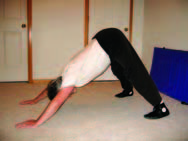
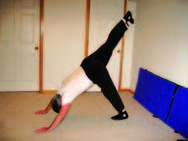
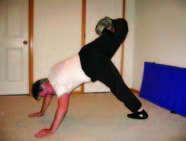
Downward Dog to Half-downward Dog to Elevated Scorpion to...
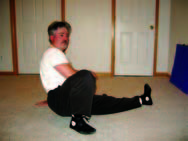
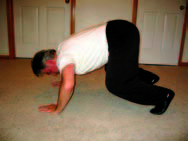
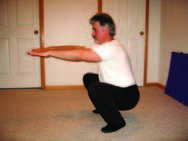
a Cossack to Frog Position to flatfoot Squat to...
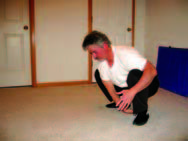
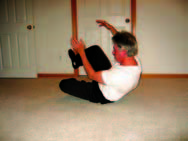
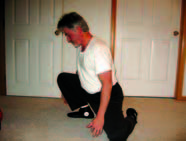
Shoulder Through Roll to shin Squat then back to Flatfoot Squat
The “secret” buried within Body-Flow™ is the methodology of linking positional exercises – or asanas. Which can be broken down and written as match-patch or hem. You can match the beginning of one movement directly to the end of another creating a short chain of movement. If the positions can’t be matched directly, they can often be patched – which is where you take one movement and patchwork them together with another, smoothing out the transition as you practice the sequence, or hemmed, which is where you take a movement and “sew” it at a similar transition spot into another movement. The goal of all this, if you can’t figure it out, is to develop smooth transitions between movements, while keeping your structure and your breathing running smoothly.
Once I figured out how it all worked, and spent some time practicing various movement sequences, I noticed, and my teammates commented on, how much smoother my game became. I spent less time struggling going from one move, or position, to another, and spent more of my energy crafting applicable strategy and tactics to use on the mat.
“Practical Application”
If you’re paying attention to the sequences of photos above, you’ll notice that the solo series of movements – while similar to the sequence to photos showing the practical application – are not the same. This is on purpose. I am a BIG believer in the training idea of stimulation vs. simulation. My goal is to ingrain (whatever) the series of movements into my neurological memory – so that when I find myself in a similar spot, I can “move without thinking,” increasing my flow, while in, and during, the “kinetic chain.” It is NOT to simulate the actual grappling encounter (which couldn’t be done anyway, as I would be practicing in a void, without a partner). Simulation in this case would be “chain wrestling,” and while there is a place for that kind of practice in a submission athletes’ toolbox, I think you’ll find (as I did) that in the hunt for submission you’ll lose that feeling of flow, because every submission is an ending, not a transition point to a new beginning.
For me, movement comes before moves – regardless of venue – whether standup, clinch or ground.
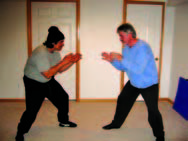
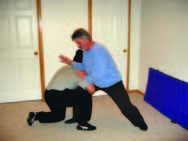
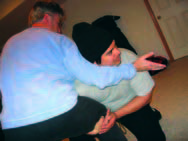
Square off - Forearm stop against a single let crossface
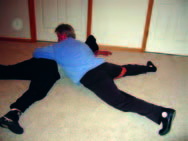
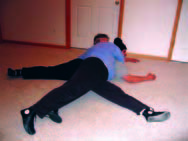
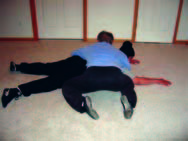
Sprawl, Scorpion, Side Control
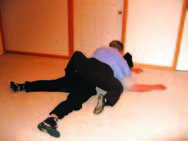
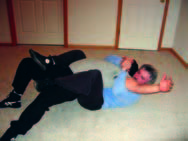
Take the back, Harness with hooks
Training Flow
I have four ways that I play Prasara Body-Flow Yoga™, though only two are applicable to this article. But please note that I am not a CST instructor or coach, nor do I play one on TV… what I “do,” how I practice, may not be what they’d prescribe. That being said, the first way I use Prasara™ is as movement prep. If I am training at a seminar, or at a school outside of my training group, I will first perform a more generalized movement set going from localized joint mobility to one that is more global, a Prasara Yoga™ based warm up for my whole body – as I don’t know what we’re going to be working on, or know who I’ll be rolling with. So I try and cover as many bases as possible given a specific time limit.
There are “similar” warm up methods of movement prep out there such as Magnificent Mobility®, or the Parisi Warm up® that you might get similar results from. But for me, I have found that going from local Joint Mobility to a more global Prasara™ is more comprehensive than either of the others – and I feel as if I can get “deeper” into my positional development. It is not JUST about warming up, or even strictly about “opening’ various areas of the body – which it is for those other two methods. For me it is more like other systems of yoga, it is also about becoming aware of the process of all those things – and more – like the state of my breathing, tension and density, structural alignment, and more.
If I am working with a group that I know, I might do a shorter version of the above to warm up, but then do some specific movement patterns to get ready for specific positional training. For example, if I knew that I was only going to be drilling guard passes, and playing from the back (offense and defense of the same positions), I would mainly work patterns that would open up my hips, quads, hamstrings, fingers, wrists, elbows, and my core – especially my lower back.
Once I have warmed up, regardless of training venue, or whether my warm up has been general or specific, the next thing I like to do is get with a partner and slow flow roll and play a positional game using and further developing my movement palette. Moving from position to position riding the energy my partner/opponent is giving me (and he too me) – using no submissions, since that would put an end cap on the “flow.” Ego noise is kept to a minimum, for the goal is to smoothly go from move to move without any interference from any source. This, for me, is a very conscious climb up the training hierarchal pyramid, going from general warm up to specific. From here I would move into the activity specific part of the training session where I'd work on my game – learning new technique, and/or work for rounds: drilling, rolling and sparring.
Which brings me to the other main way I use Prasara™, which is as compensatory exercise. Compensatory exercise is the “art” of eliminating or mitigating negative training effect. For example, if I’ve been grip fighting for an hour or two, and my forearms, wrists, and fingers are all fried I will spend some time in the Seal Pose to reduce the tension, and help eliminate the build-up of lactic acid in my forearm and finger muscles. If I’ve spent that time on my back playing guard, and my core is fried, I might do a series of shoulder bridges, yoga-wheels, and the camel pose to reduce the strain on my nervous and skeletal-muscular systems. In fact, if I could, rather than just “working” on the individual poses, which, like the Upa or shrimping drills mentioned at the beginning is an “elementary “ approach, I would put all those poses into a “kinetic chain” and work them all-as-one rather than merely individually, as the cumulative effect of moving between and through those positions is greater than the effect of just working on them one at a time.
I love playing Prasara Body-Flow Yoga™, and have seen some great advances, both to my personal practice, and thus my overall quality of movement, as well as in my practice of MMA, especially in the ground game portion of the sport. If you are looking to remove the brakes in your practical performance on the mat and want to turbo charge your approach to submission grappling I would highly recommend checking it out!
For more information on Prasara™, or Body-Flow™ go to:
http://www.rmaxinternational.com/
For a free Prasara™ Primer go to:
http://www.csthawaii.com/index.html Or: http://www.cstjapan.com/cstj_pages/eng/index.html
Body-Flow, Prasara Body-Flow, Prasara Body-Flow Yoga and Grappler’s Toolbox are trademarks of RMAX.tv Productions
There is a similar tendency in most BJJ/submission grappling classes when learning submission techniques. The instructor introduces the techniques – somewhere between one and five per lesson – with a lot of time allotted to working on the minutiae of the technique. But very little time spent on developing a method of getting to one from another. The student is often left to his own devices on that developmental front.
I have been in many classes that worked like that. A good example of this was once when I first started studying submission grappling I was in a class where we learned three techniques back to back, with the idea of “chaining” them together into a series of attacks: the Kimura from guard, the guillotine and a crucifix-type thing. We worked on the techniques individually, paying strict attention to all the details of setting them up and getting into them. Then the instructor said, “Okay, you got it, let’s roll.” Nowhere was there any instruction on how to get from one to another. So, like the good student I am, I asked: “What do I do with my hips? How do I transition to a hip-bump from the guillotine to get to the crucifix? And how am I supposed to figure all this out while some testosterone-laden gi-wearing monkey is trying to wrench my arm out of its socket?” All the instructor said was: “Welcome to the food chain.”
Yeah, thanks, and your check is in the mail…
To help sophisticate, and in a lot of cases, compensate for their practice some long-term grapplers have turned to Ginástica Natural or yoga as adjunct methodologies to help their grappling.
That is what I did. I started practicing Hatha yoga in 1982 after I started my Judo practice with a college Judo club at Colorado State University. I started practicing yoga for a variety of reasons, one of the major ones being that Judo, more than any combat sport I’ve ever undertaken – except perhaps MMA – took its toll on my body.
I started Judo just before I turned twenty, after ten years of amateur boxing, seven years of Okinawan Karate and two years of amateur kickboxing (at that time PKA rules). Judo kicked my patootie in ways I didn’t know it could be kicked. Way more than any of the other combat athletics I was involved in. By the end of my five-year college term I had amassed a pretty extensive list of injuries. None of them bad enough to keep me away from it for long, but cumulatively they added up.
Though it took some time to learn, yoga helped mitigate a lot of those injuries, helping to keep me on the mat. Yoga also helped me to develop more isometric strength – to resist submissions – that all the “conventional” weight lifting didn’t seem too. Which was a good thing, for though Judo’s ground game is generally faster and looser than most BJJ – due to their respective rule systems – it still worked similar positions and submissions, and that type of strength development was a necessary component.
Many, beside myself, have noticed that there is a lot of positional cross over between yoga and BJJ. And there is. Frog position is similar to the mount, child pose is similar to the turtle, you transition in and out of the boat pose while in open guard, et cetera. Watch some really good BJJ/submission guys rolling and you’ll see all kinds of “yoga-like” movement at play. Scorpions, downward dog, split squats, crane posture, shoulder bridges; the list goes on and on... The problem with yoga as a developmental tool for BJJ isn’t in its asanas. It’s in its training pace and methodology.
The major drawback of most “styles” of yoga for a submission athlete is that it is largely a static practice. The transitions between asanas tend to be linear – a straight line designed to get you from one pose to the next pose that you're going to be working on, which you then hold for anywhere between several seconds to several minutes depending on the "style," instructor and setting. Think Sun Salutation B from Ashtanga Vinyasa Yoga. If you have the room for a “yoga mat” you can do most forms of conventional yoga. But who – as a grappler – gets into a position on the ground against a resisting opponent and holds that position (unless it’s against his will) for a great length of time? And where have you ever seen a transition between submissions, or from sweeps to submissions, that are linear while wrestling? The nature of grappling with an opponent makes everything curvilinear or circular because you have to get around his mass.
Enter Body-Flow™
Body-Flow™, which was released by RMAX Head Coach Scott Sonnon in 2003, was an evolution upon an earlier RMAX release called Grappler’s Toolbox™. Body-Flow™ (as was the earlier GT) was an eye opener for me. Here was both a training methodology AND a set of positional “exercises” that I could make immediate use of in the development of my ground game. Prasara Body-Flow Yoga™ – released in 2005 – is the latest evolution of that methodology – one with a direct link to yoga asanas.
Before I go too far, you might ask, why did I think I “needed” this? My answer is, like the example I wrote above, that I was tired of an instructor-type telling me, “Here is position a, b, and c. Now put them together and see if you can use them,” without giving a clue as to how to get from position a-to-b-to-c, let alone develop a game out of it. Instead everything was a “mad scramble,” which in Judo, or with the wrestlers I trained with, often meant that those with the best attributes won. And, frankly, that sucked. Even before I found GT and Body-Flow™, I “knew” there had to be a better way to train the transitions between positions than grunting, scrambling and hoping for the best. I just didn’t know what that was.
An example of a simple Prasara Body-Flow Yoga™ Progression



Flatfoot squat to frog position, worm to upwards dog...



Downward Dog to Half-downward Dog to Elevated Scorpion to...



a Cossack to Frog Position to flatfoot Squat to...



Shoulder Through Roll to shin Squat then back to Flatfoot Squat
The “secret” buried within Body-Flow™ is the methodology of linking positional exercises – or asanas. Which can be broken down and written as match-patch or hem. You can match the beginning of one movement directly to the end of another creating a short chain of movement. If the positions can’t be matched directly, they can often be patched – which is where you take one movement and patchwork them together with another, smoothing out the transition as you practice the sequence, or hemmed, which is where you take a movement and “sew” it at a similar transition spot into another movement. The goal of all this, if you can’t figure it out, is to develop smooth transitions between movements, while keeping your structure and your breathing running smoothly.
Once I figured out how it all worked, and spent some time practicing various movement sequences, I noticed, and my teammates commented on, how much smoother my game became. I spent less time struggling going from one move, or position, to another, and spent more of my energy crafting applicable strategy and tactics to use on the mat.
“Practical Application”
If you’re paying attention to the sequences of photos above, you’ll notice that the solo series of movements – while similar to the sequence to photos showing the practical application – are not the same. This is on purpose. I am a BIG believer in the training idea of stimulation vs. simulation. My goal is to ingrain (whatever) the series of movements into my neurological memory – so that when I find myself in a similar spot, I can “move without thinking,” increasing my flow, while in, and during, the “kinetic chain.” It is NOT to simulate the actual grappling encounter (which couldn’t be done anyway, as I would be practicing in a void, without a partner). Simulation in this case would be “chain wrestling,” and while there is a place for that kind of practice in a submission athletes’ toolbox, I think you’ll find (as I did) that in the hunt for submission you’ll lose that feeling of flow, because every submission is an ending, not a transition point to a new beginning.
For me, movement comes before moves – regardless of venue – whether standup, clinch or ground.



Square off - Forearm stop against a single let crossface



Sprawl, Scorpion, Side Control


Take the back, Harness with hooks
Training Flow
I have four ways that I play Prasara Body-Flow Yoga™, though only two are applicable to this article. But please note that I am not a CST instructor or coach, nor do I play one on TV… what I “do,” how I practice, may not be what they’d prescribe. That being said, the first way I use Prasara™ is as movement prep. If I am training at a seminar, or at a school outside of my training group, I will first perform a more generalized movement set going from localized joint mobility to one that is more global, a Prasara Yoga™ based warm up for my whole body – as I don’t know what we’re going to be working on, or know who I’ll be rolling with. So I try and cover as many bases as possible given a specific time limit.
There are “similar” warm up methods of movement prep out there such as Magnificent Mobility®, or the Parisi Warm up® that you might get similar results from. But for me, I have found that going from local Joint Mobility to a more global Prasara™ is more comprehensive than either of the others – and I feel as if I can get “deeper” into my positional development. It is not JUST about warming up, or even strictly about “opening’ various areas of the body – which it is for those other two methods. For me it is more like other systems of yoga, it is also about becoming aware of the process of all those things – and more – like the state of my breathing, tension and density, structural alignment, and more.
If I am working with a group that I know, I might do a shorter version of the above to warm up, but then do some specific movement patterns to get ready for specific positional training. For example, if I knew that I was only going to be drilling guard passes, and playing from the back (offense and defense of the same positions), I would mainly work patterns that would open up my hips, quads, hamstrings, fingers, wrists, elbows, and my core – especially my lower back.
Once I have warmed up, regardless of training venue, or whether my warm up has been general or specific, the next thing I like to do is get with a partner and slow flow roll and play a positional game using and further developing my movement palette. Moving from position to position riding the energy my partner/opponent is giving me (and he too me) – using no submissions, since that would put an end cap on the “flow.” Ego noise is kept to a minimum, for the goal is to smoothly go from move to move without any interference from any source. This, for me, is a very conscious climb up the training hierarchal pyramid, going from general warm up to specific. From here I would move into the activity specific part of the training session where I'd work on my game – learning new technique, and/or work for rounds: drilling, rolling and sparring.
Which brings me to the other main way I use Prasara™, which is as compensatory exercise. Compensatory exercise is the “art” of eliminating or mitigating negative training effect. For example, if I’ve been grip fighting for an hour or two, and my forearms, wrists, and fingers are all fried I will spend some time in the Seal Pose to reduce the tension, and help eliminate the build-up of lactic acid in my forearm and finger muscles. If I’ve spent that time on my back playing guard, and my core is fried, I might do a series of shoulder bridges, yoga-wheels, and the camel pose to reduce the strain on my nervous and skeletal-muscular systems. In fact, if I could, rather than just “working” on the individual poses, which, like the Upa or shrimping drills mentioned at the beginning is an “elementary “ approach, I would put all those poses into a “kinetic chain” and work them all-as-one rather than merely individually, as the cumulative effect of moving between and through those positions is greater than the effect of just working on them one at a time.
I love playing Prasara Body-Flow Yoga™, and have seen some great advances, both to my personal practice, and thus my overall quality of movement, as well as in my practice of MMA, especially in the ground game portion of the sport. If you are looking to remove the brakes in your practical performance on the mat and want to turbo charge your approach to submission grappling I would highly recommend checking it out!
For more information on Prasara™, or Body-Flow™ go to:
http://www.rmaxinternational.com/
For a free Prasara™ Primer go to:
http://www.csthawaii.com/index.html Or: http://www.cstjapan.com/cstj_pages/eng/index.html
Body-Flow, Prasara Body-Flow, Prasara Body-Flow Yoga and Grappler’s Toolbox are trademarks of RMAX.tv Productions
| Chuck Kechter is a published writer and illustrator. He is the author of two novels--King of the Squared Circle and a Darkness Reflected, and a chapbook of poetry titled Furious Confection. A former amateur boxing coach, personal trainer, with decades of martial art experience, he lives in Colorado with his family. He can be reached through his website. |
Search Articles
Article Categories
Sort by Author
Sort by Issue & Date
Article Categories
Sort by Author
Sort by Issue & Date

